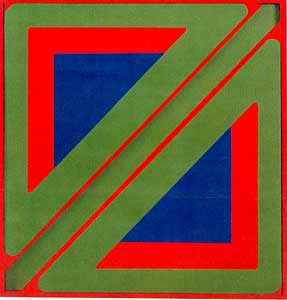José María Yturralde
This exhibition of José María Yturralde presents about fifty works, providing a retrospective view of his career as an artist from its remote abstract origins in the mid-sixties and his studies of geometrical forms and flying or floating structures to his paintings of the nineties, when in Preludios (Preludes), Interludios (Interludes) and Postludios (Postludes) he explored the dissolution of geometrical forms and concentrated on the “boundaries” of painting. The exhibition includes three kites or “figures in space”, as he calls them, installed in the entrance hall in the Centre Julio González. The last room presents previously unseen work, large-format paintings produced in recent years, based on a poetics of the immaterial and the sublime. The accompanying catalogue reproduces all the works exhibited and includes a “Diary about an exhibition” written by the artist, which gives an opportunity of becoming acquainted with many of his aesthetic and personal references, from Rothko to Zen and from Monet to Tintoretto, not forgetting contemporary music and architecture. The catalogue also includes texts by José María López Piñero and the curators of the exhibition, Daniel Giralt-Miracle and Juan Manuel Bonet. José María Yturralde (Cuenca 1942) developed an enthusiasm for drawing as a child and later studied at the Escuela de Bellas Artes de San Carlos in Valencia. In 1960 he made a study trip to Germany, France and Switzerland. In the mid-sixties he began to move towards a geometrising abstraction, exploring many different directions, including “matter” Informalism, Geometrical Abstraction, the Russian Constructivists and Vasarely, the Italian Spatialists, Fontana, Manzoni, Castellani and De Luigi. In 1966 he was made a curator at the Museo de Arte Abstracto Español in Cuenca; during this period he incorporated objects in his paintings and worked in monochrome, using synthetic materials. His interest in technology was accentuated by his participation in seminars at the Computer Centre of the University of Madrid, where he began to work with computers. In 1967 he was one of the founding members of the group Antes del Arte, which was led by the art critic Vicente Aguilera Cerni. During that period he began his experimentation with kinetic art, which subsequently led to his Figuras imposibles (Impossible Figures), Estructuras (Structures), Maclas (Macles), Perspectivas (Perspectivas) and Formas computables (Computable Forms) in Madrid. During the “impossible figures” period he devoted himself to a study of the rich collection of anatomical illustrations—ranging from the Renaissance to the twentieth century—in the Medical History Library in the University of Valencia. In 1975 he went to live in Massachusetts (USA), where he devoted himself to research and teaching at the MIT’s Center for Advanced Visual Studies. Shortly afterwards he began studying flying structures, the environment and energy systems, and he carried out various experiments with volumes using wind as a spatial support. He was an active member of the International Colour Association. The duality of art and technology or science and the humanities, which was to be found in the United States in those years and coincided with the movements of Minimal and Reductionist art, had its influence on Yturralde, especially on his aim of understanding art as an exploration, a search, a field open to all kinds of experimentation and research, uniting intelligence and sensibility. In the period between 1975 and 1986, Yturralde’s work went beyond the strictly pictorial dimension, with two- or three-dimensional forms, and attained a different spatial dimension which, without abandoning the Geometrical/Constructivist framework of his early stages, culminated in the reflection on colour fields and threshold areas that he is currently developing in depth. He produced work using lasers and holography in the University of Valencia’s Optical Laboratory, as he had done earlier in the University’s Computer Centre, and in 1979 he took part in the first public exhibition of holography at the Ateneo in Valencia, presenting a hologram based on Kepler’s idea of the universe. In the eighties, after further exploration along the lines of kinetics with his “flying structures”, he returned to the plane surface with an attitude that continued to be constructively rigorous but became more poetic as a result of the interrelationship of colours and the instability of the compositions.



